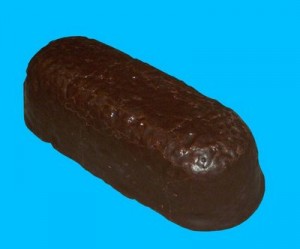 Throughout much of middle school, I had an afternoon ritual. After classes let out, I took the public bus home with a group of friends. Most of them got off before I did, with the exception of one girl who happened to live four blocks away from me. At the point where we would transfer from a downtown bus to a crosstown one, I made a slight detour, into a corner candy store. There I would purchase that most mysterious of Hostess’ snack cakes, a Chocodile. These magical items were not readily available at just any corner store — hence my need to acquire them at the mid-point of our journey. It was vaguely like Odysseus and his men stopping off at the island of the Lotus Eaters. My friend was not into Chocodiles, so she would just watch me tear into that special, delectable treat with an indulgent grin. Then we would board our connecting bus, ride east, and disembark in front of the local Hallmark store, where we would talk about nothing for about twenty minutes before going home.
Throughout much of middle school, I had an afternoon ritual. After classes let out, I took the public bus home with a group of friends. Most of them got off before I did, with the exception of one girl who happened to live four blocks away from me. At the point where we would transfer from a downtown bus to a crosstown one, I made a slight detour, into a corner candy store. There I would purchase that most mysterious of Hostess’ snack cakes, a Chocodile. These magical items were not readily available at just any corner store — hence my need to acquire them at the mid-point of our journey. It was vaguely like Odysseus and his men stopping off at the island of the Lotus Eaters. My friend was not into Chocodiles, so she would just watch me tear into that special, delectable treat with an indulgent grin. Then we would board our connecting bus, ride east, and disembark in front of the local Hallmark store, where we would talk about nothing for about twenty minutes before going home.
The history of the Chocodile is full of questions, many more questions than is usual for a confection that could reasonably be eaten in 60 seconds. For example, why is it called the Chocodile? (It can’t possibly be because anyone thought the pun was actually funny?) I mean, look at it: it’s obvious that it’s simply a Twinkie coated in chocolate. One wonders what kind of market research was done to determine that, in fact, it was worth it to create a whole new identity for what was, essentially, the cake version of peanut M&Ms. For those of you who are doubtful that any such cake ever existed, and suspect that I may be pulling your leg, rest assured that not only is the Chocodile real — if elusive — but that it once had its own cartoon mascot, Chauncey. This ethnically and regionally confusing character has since been retired, possibly because of his erroneous claim that ”it takes a while to eat a Chocodile” (as I mentioned above, it takes no time at all).
Obviously, American culture is impossible to imagine without the seductive but admittedly vulgar Twinkie (though it was eschewed by the culinarily superior Europeans), which could, throughout my childhood, be purchased in packs of two in any self-respecting deli or bodega within walking distance of my home or school. By contrast, Chocodiles were, as previously mentioned, harder to find, and sold only as singles. Perhaps Hostess had found that, when chocolate was added, a Twinkie became so sugartastic that just one packed all the emotional and caloric wallop that the average eater could stand. My own Chocodile-consuming habits bear this theory out: it was entirely possible for me to buy, and eat, more than one at a time, yet I rarely did so. In a world in which ”more” is almost invariably considered synonymous with ”better,” Chocodiles remind us that better than ”more” is ”enough.” Woe to him or her who overindulges in this unusually perfect treat.
Like so many of the pleasures of my youth, the Chocodile has been cruelly taken away from me. It has disappeared from New York City, and, I am given to understand, from the east coast entirely. This is, no doubt, at least partially attributable to the general cultural shift which has made pariahs out of sweet snacks, especially those that come pre-packaged and can survive in your cupboard for decades. Even the once-ubiquitous Twinkie two-pack has all but vanished from New York’s store shelves, replaced by dried fruit, granola bars and Smartfood. However, you can still get them boxed in the supermarket. In order to find Chocodiles — and more than a few are out there trying — one is obliged either to get in a car and hunt them down across state lines, or order them in bulk from an Internet source that may or may not be Hostess-approved. I may take the latter course, and if I do, I am sure that the reunion between me and my favorite snack will be fraught with emotion — like Penelope welcoming Odysseus home at last.
[kml_flashembed movie="http://www.youtube.com/v/m9rzDMCHfxU" width="600" height="344" allowfullscreen="true" fvars="fs=1" /]




Comments